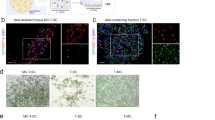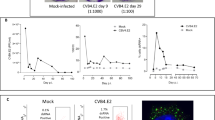Abstract
The transfer of genes encoding immunomodulatory proteins to islets can be used to improve islet function, block apoptosis, and inhibit rejection following transplantation. Adenoviral vectors have been shown to infect intact human islets, but the immunogenicity and transient gene expression of the current adenoviral vectors may hinder their use clinically for islet transplantation. In this report, we compared an HIV-1-based lentiviral vector with the E1-deleted adenoviral vehicle of the Ad5 type for gene transfer to human islets in vitro. We demonstrate that at similar viral particle concentrations per islet that an HIV-based lentiviral vector is able to infect β-cells within an intact human islet at an efficiency similar to an adenoviral vector. In addition, both the adenoviral and lentiviral vectors were able to express significant levels of soluble interleukin-1 receptor antagonist (IL-1Ra) protein following infection of intact islets. More importantly, there was no impairment of islet β-cell function following adenoviral and lentiviral infection in responding to glucose stimulation. These results support the utility of replication-defective lentiviral vectors as efficient gene delivery vehicles to islets to faciliate transplantation of islets for therapy of type I diabetes.
This is a preview of subscription content, access via your institution
Access options
Subscribe to this journal
Receive 12 print issues and online access
$259.00 per year
only $21.58 per issue
Buy this article
- Purchase on Springer Link
- Instant access to full article PDF
Prices may be subject to local taxes which are calculated during checkout




Similar content being viewed by others
References
Bach JF . Insulin-dependent diabetes mellitus as an autoimmune disease Endocr Rev 1994 15: 516–542
Eisenbarth GS . Molecular aspects of the etiology of type I diabetes mellitus J Diabetes Comp 1993 7: 142–150
Lacy PE . The intraislet macrophage and type I diabetes Mt Sinai J Med 1994 61: 170–174
Arnush M et al. Potential role of resident islet macrophage activation in the initiation of autoimmune diabetes J Immunol 1998 160: 2684–2691
Arnush M et al. IL-1 produced and released endogenously within human islets inhibits beta cell function J Clin Invest 1998 102: 516–526
Stassi G et al. Nitric oxide primes pancreatic beta cells for Fas-mediated destruction in insulin-dependent diabetes mellitus J Exp Med 1997 186: 1193–1200
Yamada K et al. Mouse islet cell lysis mediated by interleukin-1-induced Fas Diabetologia 1996 39: 1306–1312
Sandberg JO, Eizirik DL, Sandler S . IL-1 receptor antagonist inhibits recurrence of disease after syngeneic pancreatic islet transplantation to spontaneously diabetic non-obese diabetic (NOD) mice Clin Exp Immunol 1997 108: 314–317
Chao SH et al. Interleukin-10 (IL-10) prevents primary nonfunction in allogeneic islet transplantation Transplant Proc 1995 27: 602–604
Rabinovitch A et al. Combination therapy with cyclosporine and interleukin-4 or interleukin-10 prolongs survival of synergeneic pancreatic islet grafts in nonobese diabetic mice: islet graft survival does not correlate with mRNA levels of type 1 or type 2 cytokines, or transforming growth factor-beta in the islet grafts Transplantation 1997 64: 1525–1531
Deng S et al. IL-10 and TGF-beta gene transfer to rodent islets: effect on xenogeneic islet graft survival in naive and B cell-deficient mice Transplant Proc 1997 29: 2207–2208
Lenschow DJ et al. Long-term survival of xenogeneic pancreatic islet grafts induced by CTLA4Ig (see comments) Science 1992 257: 789–792
Levisetti MG et al. Immunosuppressive effects of human CTLA4Ig in a non-human primate model of allogeneic pancreatic islet transplantation J Immunol 1997 159: 5187–5191
Roy-Chaudhury P et al. CTLA4Ig attenuates acceleratedrejection (presensitization) in the mouse islet allograft model Transplantation 1997 64: 172–175
Steurer W et al. Ex vivo coating of islet cell allografts with murine CTLA4/Fc promotes graft tolerance J Immunol 1995 155: 1165–1174
Tran HM et al. Distinct mechanisms for the induction andmaintenance of allograft tolerance with CTLA4-Fc treatment J Immunol 1997 159: 2232–2239
Balasa B et al. CD40 ligand–CD40 interactions are necessary for the initiation of insulitis and diabetes in nonobese diabetic mice J Immunol 1997 159: 4620–4627
Markees TG et al. Tolerance to islet xenografts induced by dual manipulation of antigen presentation and co-stimulation Transplant Proc 1996 28: 814–815
Csete ME et al. Efficient gene transfer to pancreatic islets mediated by adenoviral vectors Transplantation 1995 59: 263–268
Csete ME et al. Adenoviral-mediated gene transfer to pancreatic islets does not alter islet function Transplant Proc 1994 26: 756–757
Benhamou PY et al. Decreased alloreactivity to human islets secreting recombinant viral interleukin 10 Transplantation 1996 62: 1306–1312
Gainer AL et al. Expression of CTLA4-Ig by biolistically transfected mouse islets promotes islet allograft survival Transplantation 1997 63: 1017–1021
Gainer AL et al. Prolongation of allograft survival of transfected islets expressing human CTLA4-Ig, human soluble Fas ligand or a combination of the two Transplant Proc 1998 30: 534
Guo Z et al. Effect of gene gun-mediated CTLA4IG and Fas ligand gene transfection on concordant xenogeneic islet graft rejection Transplant Proc 1998 30: 589
Weber M et al. Adenoviral transfection of isolated pancreatic islets: a study of programmed cell death (apoptosis) and islet function J Surg Res 1997 69: 23–32
Mulligan RC . The basic science of gene therapy Science 1993 260: 926–932
Zufferey R et al. Multiply attenuated lentiviral vector achieves efficient gene delivery in vivo Nat Biotechnol 1997 15: 871–875
Naldini L et al. Efficient transfer, integration, and sustained long-term expression of the transgene in adult rat brains injected with a lentiviral vector Proc Natl Acad Sci USA 1996 93: 11382–11388
Blomer U et al. Highly efficient and sustained gene transfer in adult neurons with a lentivirus vector J Virol 1997 71: 6641–6649
Miyoshi H et al. Stable and efficient gene transfer into the retina using an HIV-based lentiviral vector Proc Natl Acad Sci USA 1997 94: 10319–10323
Nielsen DA et al. Sorting of pancreatic islet cell subpopulations by light scattering using a fluorescence-activated cell sorter Diabetes 1982 31: 299–306
Corbett JA et al. Nitric oxide mediates IL-1 beta-induced islet dysfunction and destruction: prevention by dexamethasone Autoimmunity 1993 15: 145–153
Corbett JA, McDaniel ML . Reversibility of interleukin-1 beta-induced islet destruction and dysfunction by the inhibition of nitric oxide synthase Biochem J 1994 299: 719–724
Corbett JA, McDaniel ML . Intraislet release of interleukin 1 inhibits beta cell function by inducing beta cell expression of inducible nitric oxide synthase J Exp Med 1995 181: 559–568
Ju Q et al. Transduction of non-dividing adult human pancreatic beta cells by an integrating lentiviral vector Diabetologia 1998 41: 736–739
Peakman M et al. Development of techniques for obtaining monodispersed human islet cells Transplantation 1994 57: 384–393
Deng S et al. Adenoviral transfection of canine islet xenografts with immunosuppressive cytokine genes abrogates primary nonfunction and prolongs graft survival Transplant Proc 1997 29: 770
Corbett JA et al. Nitric oxide mediates cytokine-induced inhibition of insulin secretion by human islets of Langerhans Proc Natl Acad Sci USA 1993 90: 1731–1735
Stassi G et al. Expression of apoptosis-inducing CD95 (Fas/Apo-1) on human beta-cells sorted by flow-cytometry and cultured in vitro Transplant Proc 1995 27: 3271–3275
Hardy S et al. Construction of adenovirus vectors throughcre-lox recombination J Virol 1997 71: 1842–1849
Mittereder N, March KL, Trapnell BC . Evaluation of the concentration and bioactivity of adenovirus vectors for gene therapy J Virol 1996 70: 7498–7509
Linetsky E et al. Improved human islet isolation using a new enzyme blend, liberase Diabetes 1997 46: 1120–1123
Acknowledgements
We thank Elina Linetsky and Alessandra Ranuncoli from the Diabetes Research Institute of the University of Florida School of Medicine for human islet isolation. We also thank Joanna Stanson for the FACS analysis. NG is a recipient of a post-doctoral fellowship from the Juvenile Diabetes Foundation International and the Fonds pour la Formation de Chercheurs et à l’Aide à la Recherche prize (Fonds FCAR) of the provincial government of Quebec, Canada. This work was supported in part by Public Health Service Award DK44395 from the National Institutes of Health.
Author information
Authors and Affiliations
Rights and permissions
About this article
Cite this article
Giannoukakis, N., Mi, Z., Gambotto, A. et al. Infection of intact human islets by a lentiviral vector. Gene Ther 6, 1545–1551 (1999). https://doi.org/10.1038/sj.gt.3300996
Received:
Accepted:
Published:
Issue Date:
DOI: https://doi.org/10.1038/sj.gt.3300996
Keywords
This article is cited by
-
Highly efficient ex vivo lentiviral transduction of primary human pancreatic exocrine cells
Scientific Reports (2019)
-
Simultaneous silencing of multiple RB and p53 pathway members induces cell cycle reentry in intact human pancreatic islets
BMC Biotechnology (2014)
-
Both HIV- and EIAV-based lentiviral vectors mediate gene delivery to pancreatic cancer cells and human pancreatic primary patient xenografts
Cancer Gene Therapy (2007)
-
Efficient and persistent transduction of exocrine and endocrine pancreas by adeno-associated virus type 8
Journal of Biomedical Science (2007)
-
Efficient gene delivery to human and rodent islets with double-stranded (ds) AAV-based vectors
Gene Therapy (2005)



